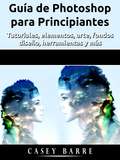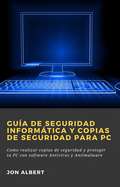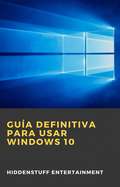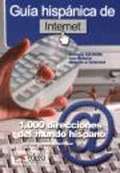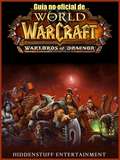- Table View
- List View
Guía Paso a Paso para Desbloquear Fire Stick Alexa TV
by Jonathan GatesGuía que explicará paso a paso como desbloquear su TV utilizando Fire Stick Alexa en sencillos pasos.
Guía de Escritores para Usar el Software de Reconocimiento de Voz
by Barbara WatkinsonComo escritores, todos sabemos lo que puede ser un increíble software de dictado de herramientas. Nos permite escribir más rápido y evitar los peligros de RSI y un estilo de vida sedentario. Pero muchos de nosotros dejamos de dictar cuando nos damos cuenta de que no podemos obtener la precisión que necesitamos para ser verdaderamente productivos. Este libro cambia todo eso. Con casi dos décadas de uso del software Dragon en su haber y una gran cantidad de conocimiento interno de la industria del dictado, en el libro se revelará cómo sobrecargar su escritura y lograr una precisión de reconocimiento inmejorable desde el momento en que comienza a usar el software.
Guía de Juego Geometry Dash Meltdown no Oficial
by Hiddenstuff Entertainment José Luis Patricio GonzálezAdemás de la compra de este libro electrónico, siéntete libre de registrarte en nuestro programa suplementario de guías gratuitas. Al copiar el link presentado a continuación ganarás acceso a las últimas actualizaciones y noticias de los juegos y aplicaciones online más populares. Regístrate de manera gratuita aquí: http://emailsignupform.subscribemenow.com/ Guía de Consejos Avanzados y Estrategias. La presente es la única y más detallada y completa guía que encontrarás online. Disponible para su descarga instantánea en tu teléfono celular, dispositivo eBook, o en formato físico. Con el éxito de mis cientos de otras guías escritas y estrategias, he escrito otra guía avanzada para tanto jugadores nuevos y veteranos. ¡Esta guía otorga estrategias específicas y consejos sobre cómo avanzar en el juego, vencer a tus oponentes, adquirir más monedas, y mucho más! Lo siguiente es lo que adquirirás con la compra de esta guía profesional avanzada y detallada de juego. - Estrategias y consejos profesionales. - Trucos y hacks. - ¡Secretos, consejos, trampas, desbloqueables, y trucos usados por jugadores profesionales! - Cómo conseguir muchas cantidades de dinero/monedas. - ¡Y MUCHO MÁS! Todas las versiones de esta guía poseen capturas de pantalla para ayudarte a entender de mejor manera el juego. No existe otra guía tan avanzada y completa como ésta. Si estás buscando guías sobre otros juegos y aplicaciones populares siéntete libre de buscar otros títulos por Joshua J Abbott o HSE Games. Estarás contento de haber comprado esta guía, y te beneficiarás de ella enormemente comparado a otras guías menos efectivos que circulan por la web. ¡Cómprala ahora y destruye a tus oponentes! ¡Conviértete en un jugador profesional hoy! Para soporte y mayor información sobre nuestros productos, visita: http://www.hiddenstuffentertainment.
Guía de Juego para Angry Birds Guerra de las Galaxias II
by Hiddenstuff Entertainment Tania CalderonCon mi última Guía de Juego de Angry Birds Star Wars II aprenderás exactamente lo que necesitas saber para convertirte en un jugador experto y obtener los puntajes más altos en cada nivel. Esta es una guía completa con todo lo que necesitas saber del juego Y ADEMÁS podrás bajar el juego gratis con esta compra. *Cómo bajar el juego Angry Birds Star Wars II GRATIS. *Secretos, tips, trampas y trucos usados por los jugadores profesionales. *Accesible para PC, IPhone y Android. *Una vista detallada de todos los pájaros. *Paso a paso de como vencer el nivel, obtener 3 estrellas y conseguir los puntajes más altos. *Vista de los logros. *Vista de todos los Mapas del Tesoro. *Vista de las Cajas de Bonus. *Vívidas capturas de pantalla. *Estrategias generales para el juego. *¡Y MUCHO MÁS! ¡Compra ahora y nunca más te quedes atorado tratando de pasar un nivel! ¡Conviértete en un Jugador de Altos Puntajes hoy! Aviso Legal Este producto no está asociado, afiliado, respaldado o patrocinado po Rovio Enterteinment Ltd. ni ha sido revisado, probado o certificado por Rovio Enterteinment Ltd. Esta guía debe ser usada como referencia y por tanto no modifica el programa en manera alguna. Esta es una guía escrita, no un programa de software.
Guía de Juego para Disney Crossy Road
by The Yuw Cecilia Esquivel B.*Guía No Official* Guía de tips avanzados y estrategías. Esta es la mas comprensica y más detallada guía que vas a encontrar en el internet. Disponible para descarga inmediata en teléfonos móviles, tabletas digitales para libros y tambien en fotmaro físico. Con el éxito de muchas otras guías de estrategías, que he escrito, ahora les traigo una guía profecional tanto para principiantes como para expertos en el juego. Proporcionando etrategías y tips específicos sobre como avanzar en el juego, conseguir más monedas, y mucho más. Todas las versiones de esta guía cuentan con gráficos e imagenes para facilitar su comprensión. Este producto no está asociado, afiliado o es patrocinado por los poseedores de la Copia Original de Derechos, no han sido revisados, probados o certificados por ninguno de los anteriores.
Guía de Photoshop para Principiantes: Tutoriales, elementos, arte, fondos, diseño, herramientas y más
by Hiddenstuff EntertainmentUna guía detallada para aprender a editar en Photoshop Esta guía lo ayudará a aprender acerca de las herramientas de Photoshop, su uso, el panel de capas de fondo y los colores. Basándose en una investigación detallada, este libro le enseñará cómo: - Realizar un conjunto de las mejores herramientas - Controlar el Panel de capas - Usar diferentes formatos para la impresión - Usarar pinceles, patrones y formas - Alterar los colores con capas de ajuste - Usar la barra de herramienta pluma - Usar atajos de teclado Si desea aprender los conceptos básicos de la edición de photoshop, entonces este libro es para usted. --> Desplácese a la parte superior de la página y haga clic en Añadir al carrito para comprar instantáneamente... Descargo de responsabilidad: Este autor y/o propietario(s) de los derechos no realiza ningún reclamo, promesa o garantía sobre la exactitud, integridad o adecuación del contenido de este libro, y expresamente renuncia a la responsabilidad por errores y omisiones en el contenido del mismo. Este producto es sólo para uso de referencia.
Guía de Usuario de Alexa 2019: A - Z Guía de referencia de Amazon Alexa para principiantes y usuarios avanzados
by Paul GartenAprende cómo usar Alexa con tu Smartphone y todos los dispositivos Amazon Echo. Edición 2019. Como el título sugiere, este libro está diseñado para ser una guía de referencia para todo lo que necesitas de los dispositivos Amazon Alexa y Echo smart. Descubre cómo configurar tus dispositivos Smart Home con Alexa. Domina tus Dispositivos Echo y Alexa en una hora. Mejora tu vida inteligente con esta guía. Desde Comunicación con Alexa, Skills, Entretenimiento, Productividad, Deporte, Compras por Voz, Noticias e Información, Configuración y Personalización dentro de la aplicación de Alexa, este libro lo cubre todo. Puedes tener una rápida vista previa del libro para ver su tabla de contenido.
Guía de Usuario de Amazon Echo: además de la completa guía de usuario y consejos
by Bob BabsonGuía de usuario de Amazon Echo: Dot, Show, Spot, Look, además de la completa guía de usuario y consejos por Bob Babson Una guía paso a paso sobre cómo sacar el máximo provecho de su dispositivo Amazon Echo Guía de usuario de Amazon Echo: Dot, Show, Spot, Look, además de la completa guía de usuario y consejos Una guía paso a paso sobre cómo sacar el máximo provecho de su dispositivo Amazon Echo * Admite todos los dispositivos Amazon Echo * La mejor característica del Echo es la inmensa funcionalidad que tiene. Aprenda a usar su dispositivo con todas sus capacidades, como lo hacen los profesionales Aquí está lo que obtendrás: -Compartir cuentas -Configuración -Alexa -Conectividad Bluetooth -Recordatorios -Rastreo de paquetes -Controlando otros dispositivos -Opciones -Actualización -Solución de problemas + ¡MUCHO MÁS! --> Desplácese a la parte superior de la página y haga clic en añadir al carrito para comprar instantáneamente... Descargo de responsabilidad: Este autor y/o propietario(s) de los derechos no hace ninguna reclamación, promesa o garantía sobre la exactitud, integridad o adecuación del contenido de este libro, y expresamente renuncia a la responsabilidad por errores y omisiones en el contenido del mismo. Este producto es sólo para uso de referencia.
Guía de Usuario no Oficial para Chromebook: La guía completa a las apps, instalación, herramientas, consejos, usar su dispositivo y más
by Bob Babson¿Usa su Chromebook regularmente? ¿Le gustaría aprender cómo usar su Chromebook como un profesional y ahorrárse montones de tiempo? Compatible con todas las versiones de Chromebook. Si su respuesta fue "sí" a cualquiera de estas preguntas, entonces esta guía es para usted. ¿Sabía que su Chromebook es capaz de miles de funciones, y que cada una de ellas hará su vida más fácil y le permitirá aprovechar mejor su tiempo? Sin embargo, debido a que hay tantas funcionalidades secretas, puede ser difícil saber exactamente cómo utilizar su dispositivo de forma óptima. Qué se incluye: -Cómo configurar. -Cómo navegar. -Capacidades del dispositivo -Cómo aprovechar mejor su tiempo -Cómo ahorrar esfuerzo y completar tareas con facilidad -Aprenda a utilizar su dispositivo como los profesionaless lo hacen. -Resolución de problemas + ¡MUCHO MÁS! Si quiere aprender a utilizar su dispositivo como los profesionales lo hacen, esta guía es para usted. --> Vaya al principio de la página y haga click en Añadir al Carrito Instantáneamente Advertencia: El autor y o el (los) propietario(s) de los derecho(s) no hacen ninguna declaración, promesa o garantía de la precisión, completitud o de la adecuación de los contenidos de este libro, y expresamente niegan responsabilidad alguna por errores y omisiones en los contenidos aquí expuestos. Este producto es para uso referencial únicamente. Por favor consulte a un profesional antes de actuar en base a cualquiera de los contenidos presentados a continuación.
Guía de desintoxicación digital: Cómo vencer la adicción a las redes sociales
by Gary RandolphAunque las redes sociales son una gran herramienta para comunicarse con los amigos y la familia, y para adquirir conocimientos e información, su uso sin límites no es bueno para la salud mental. Hoy en día las personas se han vuelto adictas a las redes sociales y también la actividad física que realizan ha disminuido. Si te has vuelto adicto a las redes sociales y quieres cambiar tus hábitos cotidianos, esta guía es para ti. Esta guía electrónica describe el proceso completo de Desintoxicación Digital. Si quieres vencer la adicción a las redes sociales, esta guía es para ti. En esta guía aprenderás: - Las diez mejores maneras de deshacerse de la adicción a las redes sociales - Cuentas que debes eliminar - Hacer un uso mínimo de las cuentas - Cómo limitar tu lista de amigos - Uso mínimo del dispositivo - Reorganizar tus prioridades - Tener tiempo libre para tus relaciones reales - Pasos a seguir - ¡Y mucho más! --> Desplácese hasta la parte superior de la página y seleccione "Añadir al carrito" para comprar inmediatamente Aviso de responsabilidad: Este autor y/o el/los propietario/s de los derechos de autor no aseguran, ni prometen, ni garantizan la exactitud, integridad o adecuación del contenido de este libro, y no se hacen responsables de los errores u omisiones en su contenido. Este producto es sólo para uso de referencia. Por favor, consulte a un profesional antes de aplicar cualquier medida sobre los temas incluidos en este libro.
Guía de juego Minecraft no Oficial
by Joshua Abbott José Luis Patricio González¡Con mi Guía Definitiva de Minecraft aprenderás exactamente lo que necesitas saber para convertirte en un jugador experto! La presente es una guía completa con todo lo que necesitas saber sobre el juego y ADEMÁS serás capaz de descargar una copia gratis del juego por la compra de esta guía. - Resume e información básica. - Estrategias avanzadas. - Todo sobre los objetos. - Todo sobre los Mobs. - Todo sobre los Biomas. - Todo sobre los encantamientos. - Todo sobre el crafteo. - Todo sobre los brebajes. - Todo sobre las mazmorras. - Todo sobre los mini juegos. - Todo sobre las granjas. - Cómo encontrar y derrotar al Ender Dragon. - Cómo conseguir objetos infinitos. - ¡Secretos, consejos, desbloqueables, y trucos usados por los jugadores profesionales! - Capturas de pantalla reales. - ¡Y MUCHO MÁS! ¡Cómprala ahora y nunca más tendrás que luchar por sobrevivir! ¡Conviértete en un jugador profesional!
Guía de juego no oficial de Angry Birds 2
by Hiddenstuff Entertainment Rafael J. Torres Gila¡Gana niveles, consigue Power-ups y obtén la mejor puntuación! ¡Con mi guía aprenderás todo lo que necesitas para convertirte en un jugador experto y superar todos los niveles! Esta es una guía completa con información imprescindible acerca del juego. - Consejos y estrategias nivel experto. - Trucos y hacks. - Recompensas diarias. - Tipos de pájaros. - Tipos de niveles. - Hechizos. - Gemas. - ¡Secretos, ayudas, trucos, desbloqueables y tácticas de jugadores profesionales! - Información relevante y estrategias de Wiki. - Estrategias generales de Apps para principiantes. - ¡Y MUCHO MÁS! ¡Consíguela ahora y acaba con tus enemigos! ¡Conviértete en un jugador profesional hoy mismo!
Guía de las GoPro Hero y Fusion: Cómo usar sus GoPro Fusion, Hero 4/5/6/7 Stock, White y Black
by Hiddenstuff Entertainment¡Aprenda a usar su dispositivo GoPro como profesional! Esta guía es para cualquiera que busque capturar videos sorprendentes con su dispositivo GoPro. Es válida para las GoPro Fusion, y Hero 4, 5, 6 y 7. Este libro incluye todo lo que necesita saber: -Hacer fotos y videos sorprendentes -Fotos de time lapse -Fotos giratorias -Compartir sus videos y fotos -Fotografía subacuática -Composición al filmar -Uso de la batería -Resolución y campo de visión -Técnicas de edición de video -¡Y MÁS!
Guía de seguridad informática y copias de seguridad para PC: Como realizar copias de seguridad y proteger tu PC con software Antivirus y Antimalware
by Jon AlbertUna guía detallada para conocer todo sobre la seguridad informática y las copias de seguridad. Esta guía te ayudará a proteger a tu ordenador de los virus, a mantener la seguridad en línea y a conocer el software de seguridad en línea gratuito. Basándose en trucos fáciles, este libro te aprenderás acerca de: - Copias de seguridad, cortafuegos, malware y antivirus. - Descarga de software gratuito. - Microsoft Security Essentials. - Protección de software Avast Free. - Software de cortafuegos. - Spyware y Adware. - Cómo utilizar los bloqueadores de ventanas emergentes. - Alternativas gratuitas para copias de seguridad. - Almacenamiento en línea. - Software de recuperación.
Guía de trucos, concejos y videos tutoriales para jugar Gru: Minion Rush
by Rosa Gallardo Ojeda Joshua AbbottEs una guía no oficial del juego Gru: Mi Villano Favorito Minion Rush el cual aprenderá exactamente lo que necesita saber para convertirse en un jugador experto y lograr la puntuación más alta! Mi guía cubre lo siguiente: - Información básico de Gru:Mi Villano Favorito: Minion Rush. - Artículos de interés. - Guía de activación. - Monedas, multiplicadores y Batalla. - Estrategias para todos los tipos de niveles. - Secretos, Consejos y trucos utilizados por los jugadores profesionales! - Instrucciones detalladas paso a paso! - Video Guía de las estrategias generales en el juego. - Y mucho más! Este producto no está asociado, afiliado, endosado, o patrocinado por Gameloft, tampoco ha sido revisado o certificados por alguien. Esta guía debe ser utilizada como referencia. De ninguna manera modifica o altera el juego. Esto es una guía escrita y no un programa del software
Guía de usuario para principiantes de Excel 2022
by Kylie CoxExcel es el software de hoja de cálculo más popular en el mundo, y por una buena razón. Es excelente, versátil, y fácil de utilizar, convirtiéndolo en una gran elección para uso personal y profesional. Excel tiene algo que ofrecerte, bien sea que estás comenzando con las hojas de cálculo, o eres un profesional experimentado. En esta guía de principiante, cubriremos las bases de Excel, de manera que puedas empezar a trabajar rápidamente.
Guía definitiva para usar Windows 10
by Hiddenstuff EntertainmentEste libro en Windows 10 es una breve guía del usuario. Enumera la forma de hacer una variedad de cosas allí usando la barra de búsqueda y dice exactamente en qué hacer clic para realizar muchas acciones necesarias. Básicamente, le dice a alguien cómo navegar por el sistema para poder usarlo de la manera más efectiva.
Guía del juego de The Simpsons Tapped Out
by Marina García Rodríguez Joshua Abbott¡Construye la mejor ciudad y consigue mucho dinero! Con la guía del juego de The Simpsons Tapped Out (o Los simpsons Springfield), aprenderás exactamente todo lo que necesitas para convertirte en un jugador experto, ¡y ganarás rosquillas y dinero ilimitados! Este libro es una guía completa sobre todo lo que necesitas saber del juego. ADEMÁS, también podrás bajarte la versión gratuita del juego con esta compra. - ¡Cómo descargar The Simpsons Tapped Out (o Los simpsons Springfield) GRATIS! - Válido para iPhone y Android. - Vista general e información básica - ¡Estrategias avanzadas para progresar en el juego! - ¡Consigue dinero ilimitado! - ¡Consigue rosquillas ilimitadas! - ¡Cómo subir de nivel más rápido! - ¡Cómo conseguir rosquillas gratis! - Ubicaciones y su código postal. - Modos de juego y logros. - Instrucciones detalladas fáciles de seguir. - ¡Los secretos, trucos y objetos descargables que solo los jugadores profesionales usan! - ¡Y MUCHO MÁS! ¡Compra ahora y no te quedes nunca más sin rosquillas! ¡Vuélvete uno de los mejores jugadores ahora! Descargo de responsabilidad: Este producto no se ha asociado, afiliado, relacionado ni financiado por EA Games, ni ha sido revisado, probado o certificado por EA Games. Esta guía debe servir como referencia, por lo que no modifica el juego de ninguna manera. Es una guía escrita y no un programa de software.
Guía del usuario de MacOS Ultimate
by Adidas Wilsona primera computadora exitosa con una GUI, la capacidad de permitir a los usuarios obtener una vista previa de un documento antes de imprimir, y un mouse fue la Mac. Las siguientes son las razones por las que ha seguido siendo relevante durante todos estos años. Iconos convertidos en arte. Dado que Mac fue la primera computadora con una GUI, fue la primera en tener íconos. Susan Kare diseñó esos primeros íconos para Mac. Las Mac ruegan por estar en red. Cuando se lanzó Mac, las redes informáticas eran exóticas y caras; pero incluso entonces, las Mac podrían conectarse fácilmente entre sí. HyperCard inspiró parcialmente la Web. La HyperCard fue creada por Bill Atkinson en 1987. A través de esta aplicación, cualquiera podía crear tarjetas en pantalla con hipervínculos, imágenes o textos. La computadora portátil Mac viene avanzada desde el primer momento, viene con muchas herramientas básicas como administración de calendario, correo electrónico, etc. Sin embargo, hay otro mundo de software poderoso para Apple Mac que facilitará las tareas complicadas. Aunque la mayoría de ellos no son gratuitos, solo cuestan unos pocos dólares y valen la pena. Aquí están algunos de los mejores.
Guía del usuario de la cámara del iPhone 14 Pro Max: El manual completo para que los principiantes aprendan a hacer fotos profesionales
by Wendy HillsSi estás deseando tener en tus manos el nuevo iPhone 14 Pro Max, si todavía estás esperando a que llegue tu iPhone, o si todavía no has pedido tu iPhone 14 Pro Max pero quieres una guía de usuario con ilustraciones que sea fácil de entender, escrita con una gramática sencilla y que te muestre cómo empezar a utilizar rápidamente tu iPhone, entonces este libro es para ti. Te mostrará cómo utilizar tu recién adquirido iPhone 14 Pro Max. El iPhone 14 Pro Max es sin duda el mejor iPhone disponible ahora mismo. Sus cámaras, su gran pantalla, su increíble diseño y su pantalla inteligente son solo algunas de las características que lo han convertido en el teléfono más comentado del mercado. El Apple iPhone 14 Pro Max es un smartphone insignia de gama alta con características avanzadas. Cuenta con una pantalla Super Retina XDR de 6,7 pulgadas, Always-On Display, funciones de visualización mejoradas y una rápida CPU A16, entre otras novedades. Esta guía de usuario te enseñará paso a paso cómo utilizar y dominar las funciones del iPhone 14 Pro Max. Al final de este libro, podrás destacar entre aquellos que solo utilizan el iPhone 14 Pro Max para cosas básicas. La compra de esta guía del usuario y su combinación con el iPhone 14 Pro Max ofrece numerosas funciones y ventajas adicionales. Este libro adopta un enfoque visual único, con instrucciones paso a paso y consejos profesionales que te enseñarán a utilizar tu iPhone 14 Pro Max como un profesional. Esta guía explica funciones complejas y básicas, consejos y trucos, y cómo configurar y utilizar eficazmente tu iPhone 14 Pro Max. Este libro contiene numerosas ilustraciones que te ayudarán a seguir la lectura a lo largo de sus páginas. Ya puedes dejar de pedir a tus hijos que te enseñen a usar el iPhone.
Guía extraoficial para Samsung Galaxy Tab 3,4 y S
by Hiddenstuff Entertainment¿Usas tu dispositivo Smsung de manera regular? ¿Te gustaría aprender a usar tu dispositivo como un profesional y ahorrar bastante tiempo? Compatible con todas las versiones 3,4, and S. Si tu respuesta a estas preguntas es si, entonces esta guía es para ti. Lo que aprenderas: -Como configurar. -Como navegar. -Capacidad deldispositivo. -Como ahorrar tiempo. -Como ahorrar esfuerzos y completar taareas con facilidad. -Aprender a usar tu dispositivo como un profesional. -Solucionar problemas del dispositivo. Y mucho más
Guía hispánica de Internet: 1,000 direcciones del mundo hispánico
by Alfredo González HermosoNo disponible
Guía no Oficial Descargable para Hacks, Mods, Apk, Wiki del Juego Family Guy en Busca de Cosas
by Joshua Abbott Roberto Vega MauryBreve guía descargable con trucos y estrategías para obtener un gran dominio del juego Family Guy: en busca de cosas.
Guía no Oficial para Microsoft Surface Tablet Go Pro 3, 4, y 5
by Bob BabsonAprenda de manera sencilla y rápida como sacar mayor provecho a los dispositivos Microsoft Surface Go Pro 3, 4 y 5, y disfrutar al máximo de sus capacidades y posibilidades.
Guía no oficial de World of Warcraft: Warlords of Draenor
by Isabel Mª Garrido Bayano Joshua Abbott*GUÍA NO OFICIAL* Guía de estrategia y consejos avanzados. Esta es la guía más detallada y completa que encontrarás online. Está disponible para descarga instantánea en tu teléfono móvil, dispositivo eBook o libro de bolsillo. Tras el éxito de mis cientos de guías y estrategias he escrito otra guía profesional avanzada para jugadores nuevos y veteranos. Te proporciona estrategias específicas y consejos sobre cómo progresar en el juego, vencer a tus enemigos, conseguir más monedas, ¡y mucho más! - Consejos y estrategias profesionales. - Trucos y hacks. - Secretos, consejos, trucos y objetos desbloqueables que usan los jugadores profesionales. - Cómo conseguir montones de dinero. - ¡Y MUCHO MÁS! Descargo de responsabilidad: Este producto no está asociado, afiliado, respaldado, certificado o patrocinado por el propietario del Copyright original.





